Strategic Quality and System Management Analysis for Next Plc Report
VerifiedAdded on 2019/12/04
|18
|6468
|155
Report
AI Summary
This report provides a comprehensive analysis of strategic quality and system management at Next Plc, a UK-based retailer. It begins by highlighting the importance of operations management in achieving organizational objectives, particularly in the competitive retail industry, and assesses the effectiveness of Next Plc's existing operational strategies. The report then explores the significance of effective quality management systems, referencing quality gurus and models like Deming's and Six Sigma, and evaluates Next Plc's current quality management processes. It identifies strategic quality changes needed to improve performance, including product and service enhancements, and outlines the resources and systems required to support these changes. The report also discusses the wider implications of these changes, including monitoring and implementation strategies, and concludes with recommendations for improvement, focusing on customer satisfaction and continuous quality enhancement.
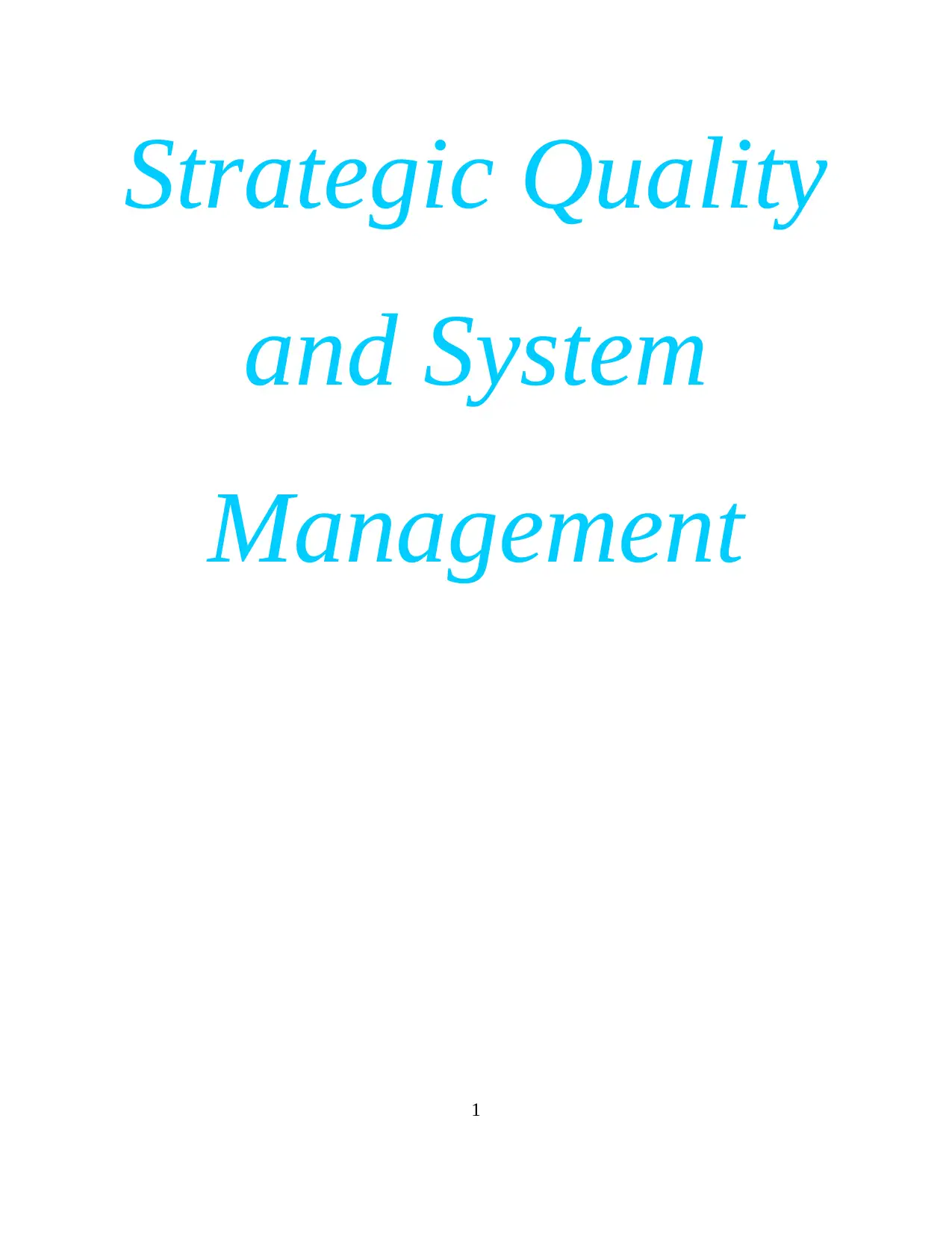
Strategic Quality
and System
Management
1
and System
Management
1
Paraphrase This Document
Need a fresh take? Get an instant paraphrase of this document with our AI Paraphraser

2
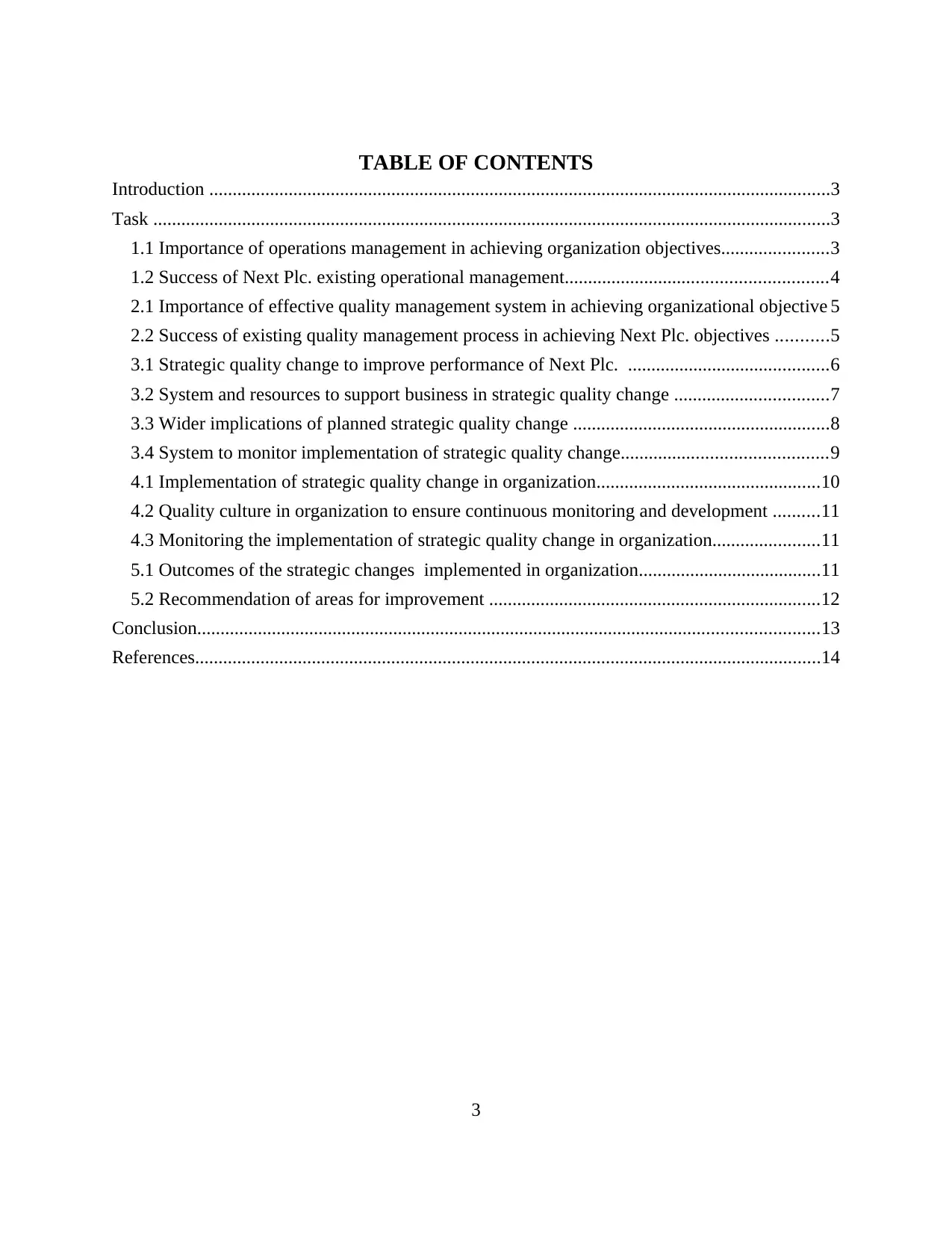
TABLE OF CONTENTS
Introduction .....................................................................................................................................3
Task .................................................................................................................................................3
1.1 Importance of operations management in achieving organization objectives.......................3
1.2 Success of Next Plc. existing operational management........................................................4
2.1 Importance of effective quality management system in achieving organizational objective 5
2.2 Success of existing quality management process in achieving Next Plc. objectives ...........5
3.1 Strategic quality change to improve performance of Next Plc. ...........................................6
3.2 System and resources to support business in strategic quality change .................................7
3.3 Wider implications of planned strategic quality change .......................................................8
3.4 System to monitor implementation of strategic quality change............................................9
4.1 Implementation of strategic quality change in organization................................................10
4.2 Quality culture in organization to ensure continuous monitoring and development ..........11
4.3 Monitoring the implementation of strategic quality change in organization.......................11
5.1 Outcomes of the strategic changes implemented in organization.......................................11
5.2 Recommendation of areas for improvement .......................................................................12
Conclusion.....................................................................................................................................13
References......................................................................................................................................14
3
Introduction .....................................................................................................................................3
Task .................................................................................................................................................3
1.1 Importance of operations management in achieving organization objectives.......................3
1.2 Success of Next Plc. existing operational management........................................................4
2.1 Importance of effective quality management system in achieving organizational objective 5
2.2 Success of existing quality management process in achieving Next Plc. objectives ...........5
3.1 Strategic quality change to improve performance of Next Plc. ...........................................6
3.2 System and resources to support business in strategic quality change .................................7
3.3 Wider implications of planned strategic quality change .......................................................8
3.4 System to monitor implementation of strategic quality change............................................9
4.1 Implementation of strategic quality change in organization................................................10
4.2 Quality culture in organization to ensure continuous monitoring and development ..........11
4.3 Monitoring the implementation of strategic quality change in organization.......................11
5.1 Outcomes of the strategic changes implemented in organization.......................................11
5.2 Recommendation of areas for improvement .......................................................................12
Conclusion.....................................................................................................................................13
References......................................................................................................................................14
3
⊘ This is a preview!⊘
Do you want full access?
Subscribe today to unlock all pages.

Trusted by 1+ million students worldwide
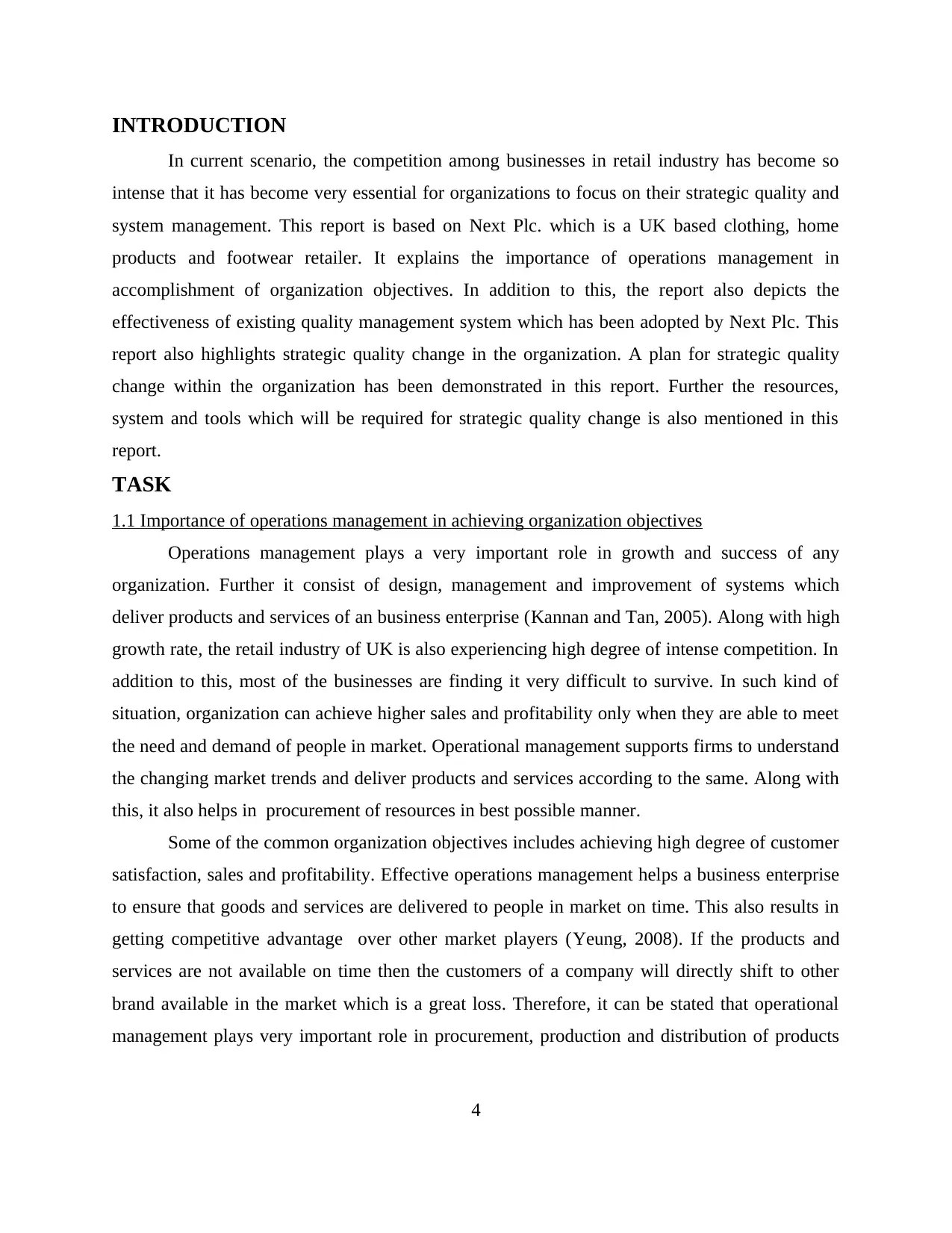
INTRODUCTION
In current scenario, the competition among businesses in retail industry has become so
intense that it has become very essential for organizations to focus on their strategic quality and
system management. This report is based on Next Plc. which is a UK based clothing, home
products and footwear retailer. It explains the importance of operations management in
accomplishment of organization objectives. In addition to this, the report also depicts the
effectiveness of existing quality management system which has been adopted by Next Plc. This
report also highlights strategic quality change in the organization. A plan for strategic quality
change within the organization has been demonstrated in this report. Further the resources,
system and tools which will be required for strategic quality change is also mentioned in this
report.
TASK
1.1 Importance of operations management in achieving organization objectives
Operations management plays a very important role in growth and success of any
organization. Further it consist of design, management and improvement of systems which
deliver products and services of an business enterprise (Kannan and Tan, 2005). Along with high
growth rate, the retail industry of UK is also experiencing high degree of intense competition. In
addition to this, most of the businesses are finding it very difficult to survive. In such kind of
situation, organization can achieve higher sales and profitability only when they are able to meet
the need and demand of people in market. Operational management supports firms to understand
the changing market trends and deliver products and services according to the same. Along with
this, it also helps in procurement of resources in best possible manner.
Some of the common organization objectives includes achieving high degree of customer
satisfaction, sales and profitability. Effective operations management helps a business enterprise
to ensure that goods and services are delivered to people in market on time. This also results in
getting competitive advantage over other market players (Yeung, 2008). If the products and
services are not available on time then the customers of a company will directly shift to other
brand available in the market which is a great loss. Therefore, it can be stated that operational
management plays very important role in procurement, production and distribution of products
4
In current scenario, the competition among businesses in retail industry has become so
intense that it has become very essential for organizations to focus on their strategic quality and
system management. This report is based on Next Plc. which is a UK based clothing, home
products and footwear retailer. It explains the importance of operations management in
accomplishment of organization objectives. In addition to this, the report also depicts the
effectiveness of existing quality management system which has been adopted by Next Plc. This
report also highlights strategic quality change in the organization. A plan for strategic quality
change within the organization has been demonstrated in this report. Further the resources,
system and tools which will be required for strategic quality change is also mentioned in this
report.
TASK
1.1 Importance of operations management in achieving organization objectives
Operations management plays a very important role in growth and success of any
organization. Further it consist of design, management and improvement of systems which
deliver products and services of an business enterprise (Kannan and Tan, 2005). Along with high
growth rate, the retail industry of UK is also experiencing high degree of intense competition. In
addition to this, most of the businesses are finding it very difficult to survive. In such kind of
situation, organization can achieve higher sales and profitability only when they are able to meet
the need and demand of people in market. Operational management supports firms to understand
the changing market trends and deliver products and services according to the same. Along with
this, it also helps in procurement of resources in best possible manner.
Some of the common organization objectives includes achieving high degree of customer
satisfaction, sales and profitability. Effective operations management helps a business enterprise
to ensure that goods and services are delivered to people in market on time. This also results in
getting competitive advantage over other market players (Yeung, 2008). If the products and
services are not available on time then the customers of a company will directly shift to other
brand available in the market which is a great loss. Therefore, it can be stated that operational
management plays very important role in procurement, production and distribution of products
4
Paraphrase This Document
Need a fresh take? Get an instant paraphrase of this document with our AI Paraphraser
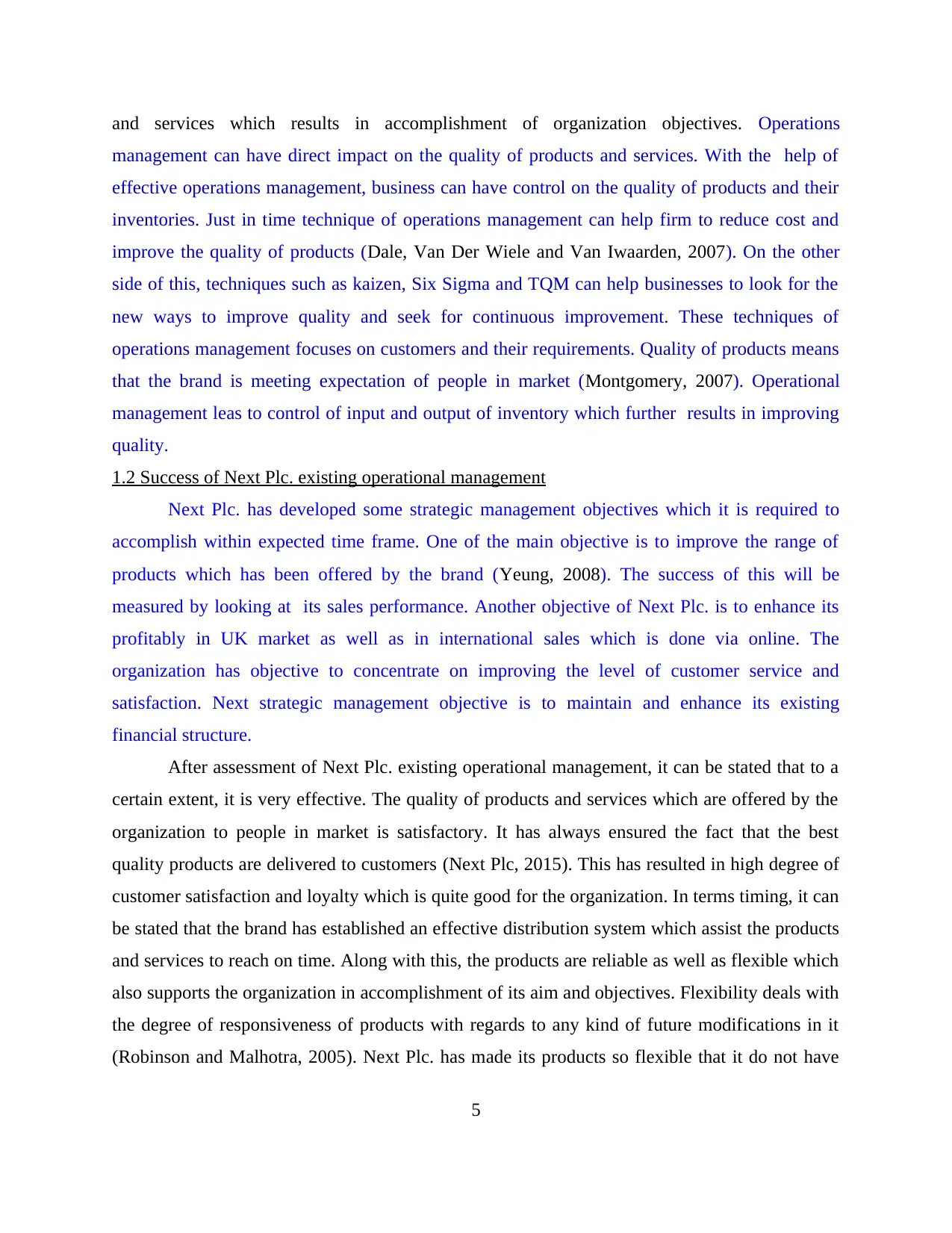
and services which results in accomplishment of organization objectives. Operations
management can have direct impact on the quality of products and services. With the help of
effective operations management, business can have control on the quality of products and their
inventories. Just in time technique of operations management can help firm to reduce cost and
improve the quality of products (Dale, Van Der Wiele and Van Iwaarden, 2007). On the other
side of this, techniques such as kaizen, Six Sigma and TQM can help businesses to look for the
new ways to improve quality and seek for continuous improvement. These techniques of
operations management focuses on customers and their requirements. Quality of products means
that the brand is meeting expectation of people in market (Montgomery, 2007). Operational
management leas to control of input and output of inventory which further results in improving
quality.
1.2 Success of Next Plc. existing operational management
Next Plc. has developed some strategic management objectives which it is required to
accomplish within expected time frame. One of the main objective is to improve the range of
products which has been offered by the brand (Yeung, 2008). The success of this will be
measured by looking at its sales performance. Another objective of Next Plc. is to enhance its
profitably in UK market as well as in international sales which is done via online. The
organization has objective to concentrate on improving the level of customer service and
satisfaction. Next strategic management objective is to maintain and enhance its existing
financial structure.
After assessment of Next Plc. existing operational management, it can be stated that to a
certain extent, it is very effective. The quality of products and services which are offered by the
organization to people in market is satisfactory. It has always ensured the fact that the best
quality products are delivered to customers (Next Plc, 2015). This has resulted in high degree of
customer satisfaction and loyalty which is quite good for the organization. In terms timing, it can
be stated that the brand has established an effective distribution system which assist the products
and services to reach on time. Along with this, the products are reliable as well as flexible which
also supports the organization in accomplishment of its aim and objectives. Flexibility deals with
the degree of responsiveness of products with regards to any kind of future modifications in it
(Robinson and Malhotra, 2005). Next Plc. has made its products so flexible that it do not have
5
management can have direct impact on the quality of products and services. With the help of
effective operations management, business can have control on the quality of products and their
inventories. Just in time technique of operations management can help firm to reduce cost and
improve the quality of products (Dale, Van Der Wiele and Van Iwaarden, 2007). On the other
side of this, techniques such as kaizen, Six Sigma and TQM can help businesses to look for the
new ways to improve quality and seek for continuous improvement. These techniques of
operations management focuses on customers and their requirements. Quality of products means
that the brand is meeting expectation of people in market (Montgomery, 2007). Operational
management leas to control of input and output of inventory which further results in improving
quality.
1.2 Success of Next Plc. existing operational management
Next Plc. has developed some strategic management objectives which it is required to
accomplish within expected time frame. One of the main objective is to improve the range of
products which has been offered by the brand (Yeung, 2008). The success of this will be
measured by looking at its sales performance. Another objective of Next Plc. is to enhance its
profitably in UK market as well as in international sales which is done via online. The
organization has objective to concentrate on improving the level of customer service and
satisfaction. Next strategic management objective is to maintain and enhance its existing
financial structure.
After assessment of Next Plc. existing operational management, it can be stated that to a
certain extent, it is very effective. The quality of products and services which are offered by the
organization to people in market is satisfactory. It has always ensured the fact that the best
quality products are delivered to customers (Next Plc, 2015). This has resulted in high degree of
customer satisfaction and loyalty which is quite good for the organization. In terms timing, it can
be stated that the brand has established an effective distribution system which assist the products
and services to reach on time. Along with this, the products are reliable as well as flexible which
also supports the organization in accomplishment of its aim and objectives. Flexibility deals with
the degree of responsiveness of products with regards to any kind of future modifications in it
(Robinson and Malhotra, 2005). Next Plc. has made its products so flexible that it do not have
5
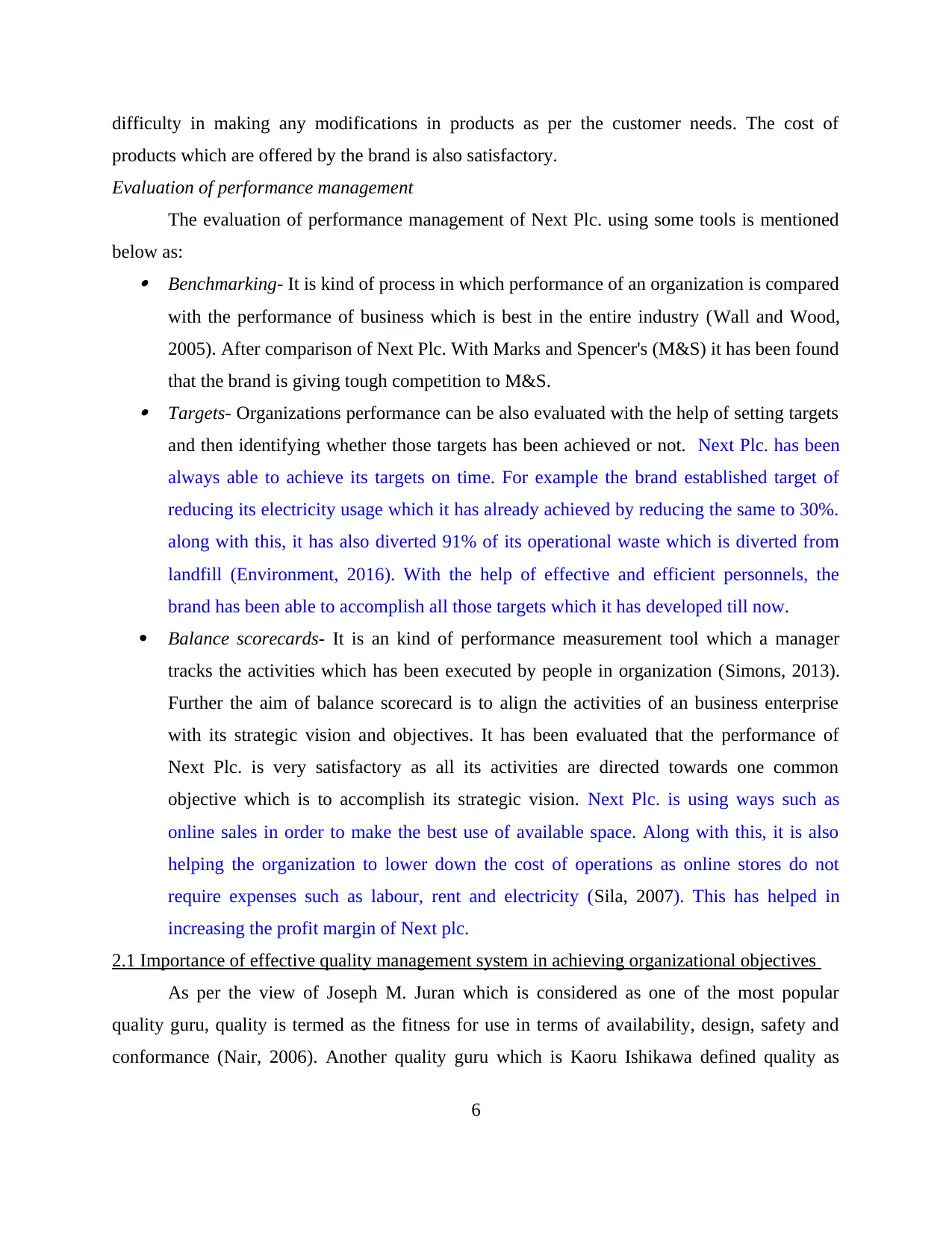
difficulty in making any modifications in products as per the customer needs. The cost of
products which are offered by the brand is also satisfactory.
Evaluation of performance management
The evaluation of performance management of Next Plc. using some tools is mentioned
below as: Benchmarking- It is kind of process in which performance of an organization is compared
with the performance of business which is best in the entire industry (Wall and Wood,
2005). After comparison of Next Plc. With Marks and Spencer's (M&S) it has been found
that the brand is giving tough competition to M&S. Targets- Organizations performance can be also evaluated with the help of setting targets
and then identifying whether those targets has been achieved or not. Next Plc. has been
always able to achieve its targets on time. For example the brand established target of
reducing its electricity usage which it has already achieved by reducing the same to 30%.
along with this, it has also diverted 91% of its operational waste which is diverted from
landfill (Environment, 2016). With the help of effective and efficient personnels, the
brand has been able to accomplish all those targets which it has developed till now.
Balance scorecards- It is an kind of performance measurement tool which a manager
tracks the activities which has been executed by people in organization (Simons, 2013).
Further the aim of balance scorecard is to align the activities of an business enterprise
with its strategic vision and objectives. It has been evaluated that the performance of
Next Plc. is very satisfactory as all its activities are directed towards one common
objective which is to accomplish its strategic vision. Next Plc. is using ways such as
online sales in order to make the best use of available space. Along with this, it is also
helping the organization to lower down the cost of operations as online stores do not
require expenses such as labour, rent and electricity (Sila, 2007). This has helped in
increasing the profit margin of Next plc.
2.1 Importance of effective quality management system in achieving organizational objectives
As per the view of Joseph M. Juran which is considered as one of the most popular
quality guru, quality is termed as the fitness for use in terms of availability, design, safety and
conformance (Nair, 2006). Another quality guru which is Kaoru Ishikawa defined quality as
6
products which are offered by the brand is also satisfactory.
Evaluation of performance management
The evaluation of performance management of Next Plc. using some tools is mentioned
below as: Benchmarking- It is kind of process in which performance of an organization is compared
with the performance of business which is best in the entire industry (Wall and Wood,
2005). After comparison of Next Plc. With Marks and Spencer's (M&S) it has been found
that the brand is giving tough competition to M&S. Targets- Organizations performance can be also evaluated with the help of setting targets
and then identifying whether those targets has been achieved or not. Next Plc. has been
always able to achieve its targets on time. For example the brand established target of
reducing its electricity usage which it has already achieved by reducing the same to 30%.
along with this, it has also diverted 91% of its operational waste which is diverted from
landfill (Environment, 2016). With the help of effective and efficient personnels, the
brand has been able to accomplish all those targets which it has developed till now.
Balance scorecards- It is an kind of performance measurement tool which a manager
tracks the activities which has been executed by people in organization (Simons, 2013).
Further the aim of balance scorecard is to align the activities of an business enterprise
with its strategic vision and objectives. It has been evaluated that the performance of
Next Plc. is very satisfactory as all its activities are directed towards one common
objective which is to accomplish its strategic vision. Next Plc. is using ways such as
online sales in order to make the best use of available space. Along with this, it is also
helping the organization to lower down the cost of operations as online stores do not
require expenses such as labour, rent and electricity (Sila, 2007). This has helped in
increasing the profit margin of Next plc.
2.1 Importance of effective quality management system in achieving organizational objectives
As per the view of Joseph M. Juran which is considered as one of the most popular
quality guru, quality is termed as the fitness for use in terms of availability, design, safety and
conformance (Nair, 2006). Another quality guru which is Kaoru Ishikawa defined quality as
6
⊘ This is a preview!⊘
Do you want full access?
Subscribe today to unlock all pages.

Trusted by 1+ million students worldwide
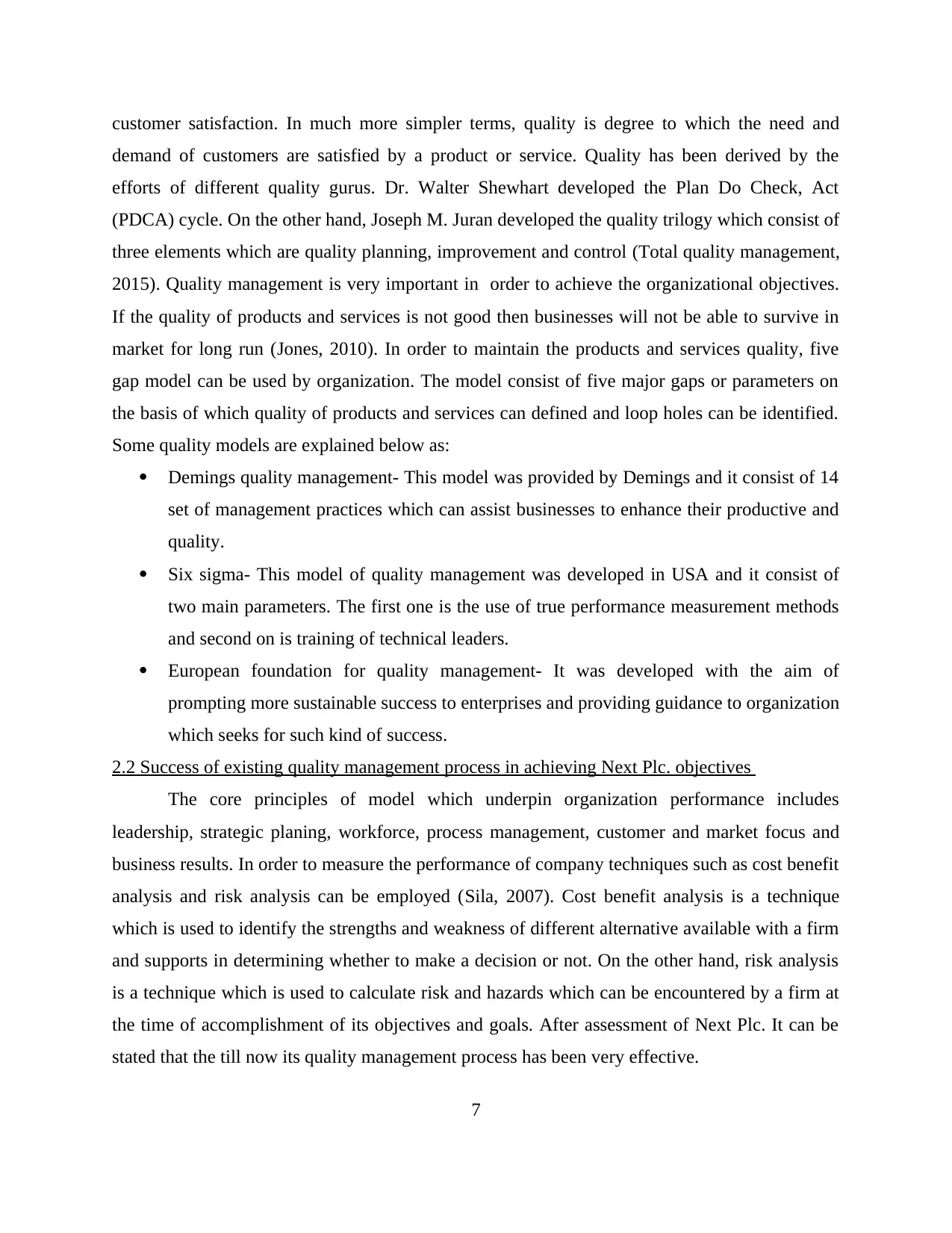
customer satisfaction. In much more simpler terms, quality is degree to which the need and
demand of customers are satisfied by a product or service. Quality has been derived by the
efforts of different quality gurus. Dr. Walter Shewhart developed the Plan Do Check, Act
(PDCA) cycle. On the other hand, Joseph M. Juran developed the quality trilogy which consist of
three elements which are quality planning, improvement and control (Total quality management,
2015). Quality management is very important in order to achieve the organizational objectives.
If the quality of products and services is not good then businesses will not be able to survive in
market for long run (Jones, 2010). In order to maintain the products and services quality, five
gap model can be used by organization. The model consist of five major gaps or parameters on
the basis of which quality of products and services can defined and loop holes can be identified.
Some quality models are explained below as:
Demings quality management- This model was provided by Demings and it consist of 14
set of management practices which can assist businesses to enhance their productive and
quality.
Six sigma- This model of quality management was developed in USA and it consist of
two main parameters. The first one is the use of true performance measurement methods
and second on is training of technical leaders.
European foundation for quality management- It was developed with the aim of
prompting more sustainable success to enterprises and providing guidance to organization
which seeks for such kind of success.
2.2 Success of existing quality management process in achieving Next Plc. objectives
The core principles of model which underpin organization performance includes
leadership, strategic planing, workforce, process management, customer and market focus and
business results. In order to measure the performance of company techniques such as cost benefit
analysis and risk analysis can be employed (Sila, 2007). Cost benefit analysis is a technique
which is used to identify the strengths and weakness of different alternative available with a firm
and supports in determining whether to make a decision or not. On the other hand, risk analysis
is a technique which is used to calculate risk and hazards which can be encountered by a firm at
the time of accomplishment of its objectives and goals. After assessment of Next Plc. It can be
stated that the till now its quality management process has been very effective.
7
demand of customers are satisfied by a product or service. Quality has been derived by the
efforts of different quality gurus. Dr. Walter Shewhart developed the Plan Do Check, Act
(PDCA) cycle. On the other hand, Joseph M. Juran developed the quality trilogy which consist of
three elements which are quality planning, improvement and control (Total quality management,
2015). Quality management is very important in order to achieve the organizational objectives.
If the quality of products and services is not good then businesses will not be able to survive in
market for long run (Jones, 2010). In order to maintain the products and services quality, five
gap model can be used by organization. The model consist of five major gaps or parameters on
the basis of which quality of products and services can defined and loop holes can be identified.
Some quality models are explained below as:
Demings quality management- This model was provided by Demings and it consist of 14
set of management practices which can assist businesses to enhance their productive and
quality.
Six sigma- This model of quality management was developed in USA and it consist of
two main parameters. The first one is the use of true performance measurement methods
and second on is training of technical leaders.
European foundation for quality management- It was developed with the aim of
prompting more sustainable success to enterprises and providing guidance to organization
which seeks for such kind of success.
2.2 Success of existing quality management process in achieving Next Plc. objectives
The core principles of model which underpin organization performance includes
leadership, strategic planing, workforce, process management, customer and market focus and
business results. In order to measure the performance of company techniques such as cost benefit
analysis and risk analysis can be employed (Sila, 2007). Cost benefit analysis is a technique
which is used to identify the strengths and weakness of different alternative available with a firm
and supports in determining whether to make a decision or not. On the other hand, risk analysis
is a technique which is used to calculate risk and hazards which can be encountered by a firm at
the time of accomplishment of its objectives and goals. After assessment of Next Plc. It can be
stated that the till now its quality management process has been very effective.
7
Paraphrase This Document
Need a fresh take? Get an instant paraphrase of this document with our AI Paraphraser
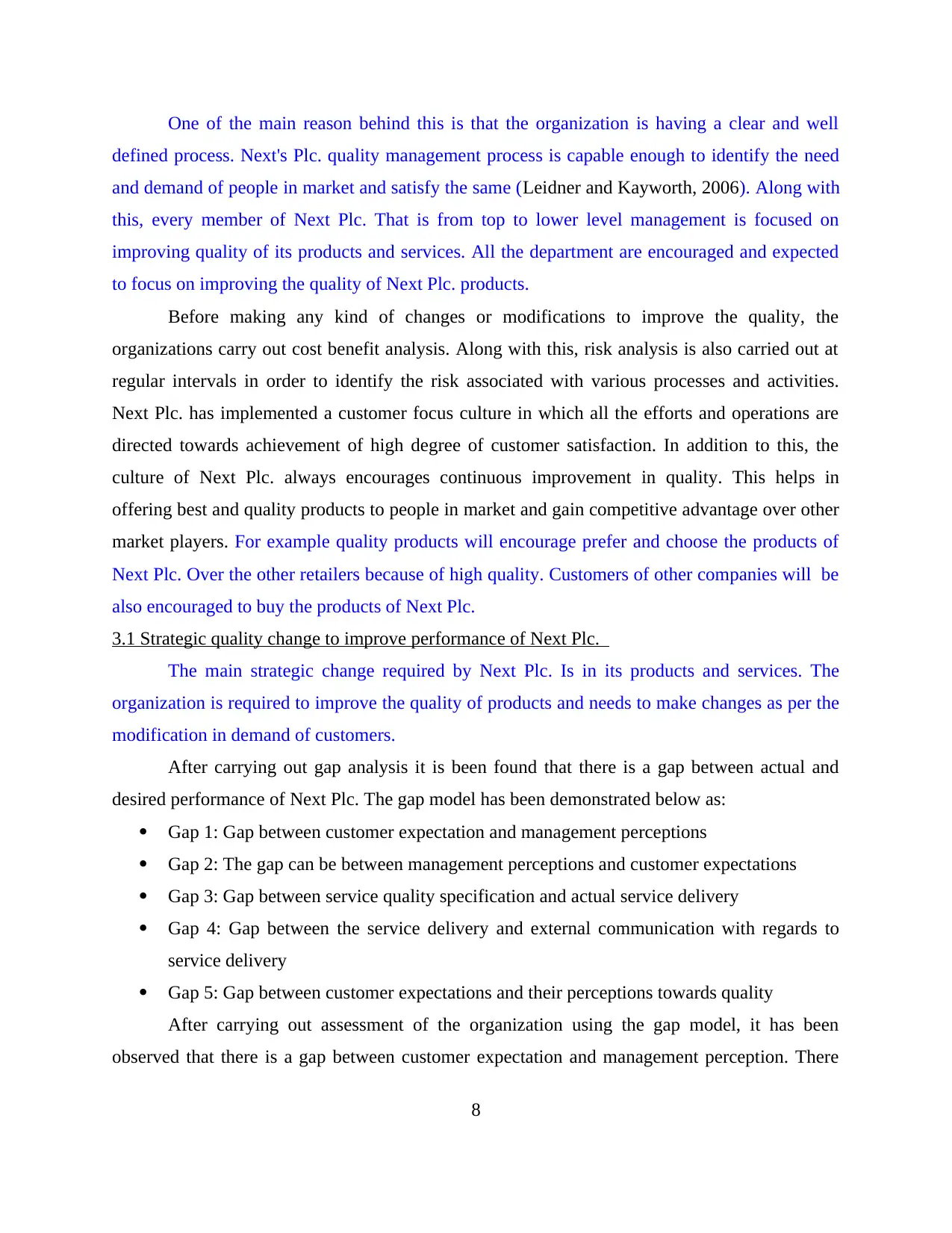
One of the main reason behind this is that the organization is having a clear and well
defined process. Next's Plc. quality management process is capable enough to identify the need
and demand of people in market and satisfy the same (Leidner and Kayworth, 2006). Along with
this, every member of Next Plc. That is from top to lower level management is focused on
improving quality of its products and services. All the department are encouraged and expected
to focus on improving the quality of Next Plc. products.
Before making any kind of changes or modifications to improve the quality, the
organizations carry out cost benefit analysis. Along with this, risk analysis is also carried out at
regular intervals in order to identify the risk associated with various processes and activities.
Next Plc. has implemented a customer focus culture in which all the efforts and operations are
directed towards achievement of high degree of customer satisfaction. In addition to this, the
culture of Next Plc. always encourages continuous improvement in quality. This helps in
offering best and quality products to people in market and gain competitive advantage over other
market players. For example quality products will encourage prefer and choose the products of
Next Plc. Over the other retailers because of high quality. Customers of other companies will be
also encouraged to buy the products of Next Plc.
3.1 Strategic quality change to improve performance of Next Plc.
The main strategic change required by Next Plc. Is in its products and services. The
organization is required to improve the quality of products and needs to make changes as per the
modification in demand of customers.
After carrying out gap analysis it is been found that there is a gap between actual and
desired performance of Next Plc. The gap model has been demonstrated below as:
Gap 1: Gap between customer expectation and management perceptions
Gap 2: The gap can be between management perceptions and customer expectations
Gap 3: Gap between service quality specification and actual service delivery
Gap 4: Gap between the service delivery and external communication with regards to
service delivery
Gap 5: Gap between customer expectations and their perceptions towards quality
After carrying out assessment of the organization using the gap model, it has been
observed that there is a gap between customer expectation and management perception. There
8
defined process. Next's Plc. quality management process is capable enough to identify the need
and demand of people in market and satisfy the same (Leidner and Kayworth, 2006). Along with
this, every member of Next Plc. That is from top to lower level management is focused on
improving quality of its products and services. All the department are encouraged and expected
to focus on improving the quality of Next Plc. products.
Before making any kind of changes or modifications to improve the quality, the
organizations carry out cost benefit analysis. Along with this, risk analysis is also carried out at
regular intervals in order to identify the risk associated with various processes and activities.
Next Plc. has implemented a customer focus culture in which all the efforts and operations are
directed towards achievement of high degree of customer satisfaction. In addition to this, the
culture of Next Plc. always encourages continuous improvement in quality. This helps in
offering best and quality products to people in market and gain competitive advantage over other
market players. For example quality products will encourage prefer and choose the products of
Next Plc. Over the other retailers because of high quality. Customers of other companies will be
also encouraged to buy the products of Next Plc.
3.1 Strategic quality change to improve performance of Next Plc.
The main strategic change required by Next Plc. Is in its products and services. The
organization is required to improve the quality of products and needs to make changes as per the
modification in demand of customers.
After carrying out gap analysis it is been found that there is a gap between actual and
desired performance of Next Plc. The gap model has been demonstrated below as:
Gap 1: Gap between customer expectation and management perceptions
Gap 2: The gap can be between management perceptions and customer expectations
Gap 3: Gap between service quality specification and actual service delivery
Gap 4: Gap between the service delivery and external communication with regards to
service delivery
Gap 5: Gap between customer expectations and their perceptions towards quality
After carrying out assessment of the organization using the gap model, it has been
observed that there is a gap between customer expectation and management perception. There
8
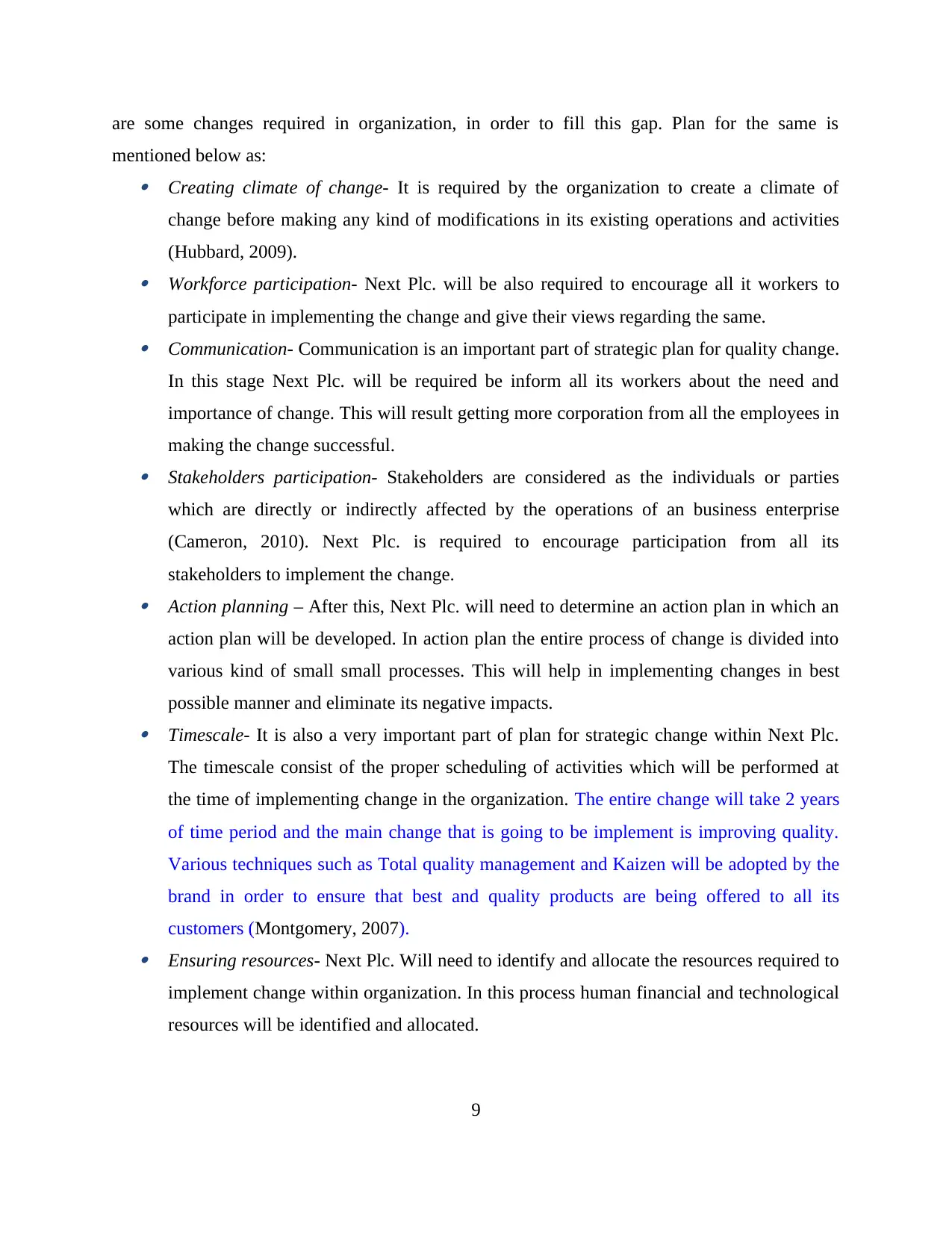
are some changes required in organization, in order to fill this gap. Plan for the same is
mentioned below as: Creating climate of change- It is required by the organization to create a climate of
change before making any kind of modifications in its existing operations and activities
(Hubbard, 2009). Workforce participation- Next Plc. will be also required to encourage all it workers to
participate in implementing the change and give their views regarding the same. Communication- Communication is an important part of strategic plan for quality change.
In this stage Next Plc. will be required be inform all its workers about the need and
importance of change. This will result getting more corporation from all the employees in
making the change successful. Stakeholders participation- Stakeholders are considered as the individuals or parties
which are directly or indirectly affected by the operations of an business enterprise
(Cameron, 2010). Next Plc. is required to encourage participation from all its
stakeholders to implement the change. Action planning – After this, Next Plc. will need to determine an action plan in which an
action plan will be developed. In action plan the entire process of change is divided into
various kind of small small processes. This will help in implementing changes in best
possible manner and eliminate its negative impacts. Timescale- It is also a very important part of plan for strategic change within Next Plc.
The timescale consist of the proper scheduling of activities which will be performed at
the time of implementing change in the organization. The entire change will take 2 years
of time period and the main change that is going to be implement is improving quality.
Various techniques such as Total quality management and Kaizen will be adopted by the
brand in order to ensure that best and quality products are being offered to all its
customers (Montgomery, 2007). Ensuring resources- Next Plc. Will need to identify and allocate the resources required to
implement change within organization. In this process human financial and technological
resources will be identified and allocated.
9
mentioned below as: Creating climate of change- It is required by the organization to create a climate of
change before making any kind of modifications in its existing operations and activities
(Hubbard, 2009). Workforce participation- Next Plc. will be also required to encourage all it workers to
participate in implementing the change and give their views regarding the same. Communication- Communication is an important part of strategic plan for quality change.
In this stage Next Plc. will be required be inform all its workers about the need and
importance of change. This will result getting more corporation from all the employees in
making the change successful. Stakeholders participation- Stakeholders are considered as the individuals or parties
which are directly or indirectly affected by the operations of an business enterprise
(Cameron, 2010). Next Plc. is required to encourage participation from all its
stakeholders to implement the change. Action planning – After this, Next Plc. will need to determine an action plan in which an
action plan will be developed. In action plan the entire process of change is divided into
various kind of small small processes. This will help in implementing changes in best
possible manner and eliminate its negative impacts. Timescale- It is also a very important part of plan for strategic change within Next Plc.
The timescale consist of the proper scheduling of activities which will be performed at
the time of implementing change in the organization. The entire change will take 2 years
of time period and the main change that is going to be implement is improving quality.
Various techniques such as Total quality management and Kaizen will be adopted by the
brand in order to ensure that best and quality products are being offered to all its
customers (Montgomery, 2007). Ensuring resources- Next Plc. Will need to identify and allocate the resources required to
implement change within organization. In this process human financial and technological
resources will be identified and allocated.
9
⊘ This is a preview!⊘
Do you want full access?
Subscribe today to unlock all pages.

Trusted by 1+ million students worldwide
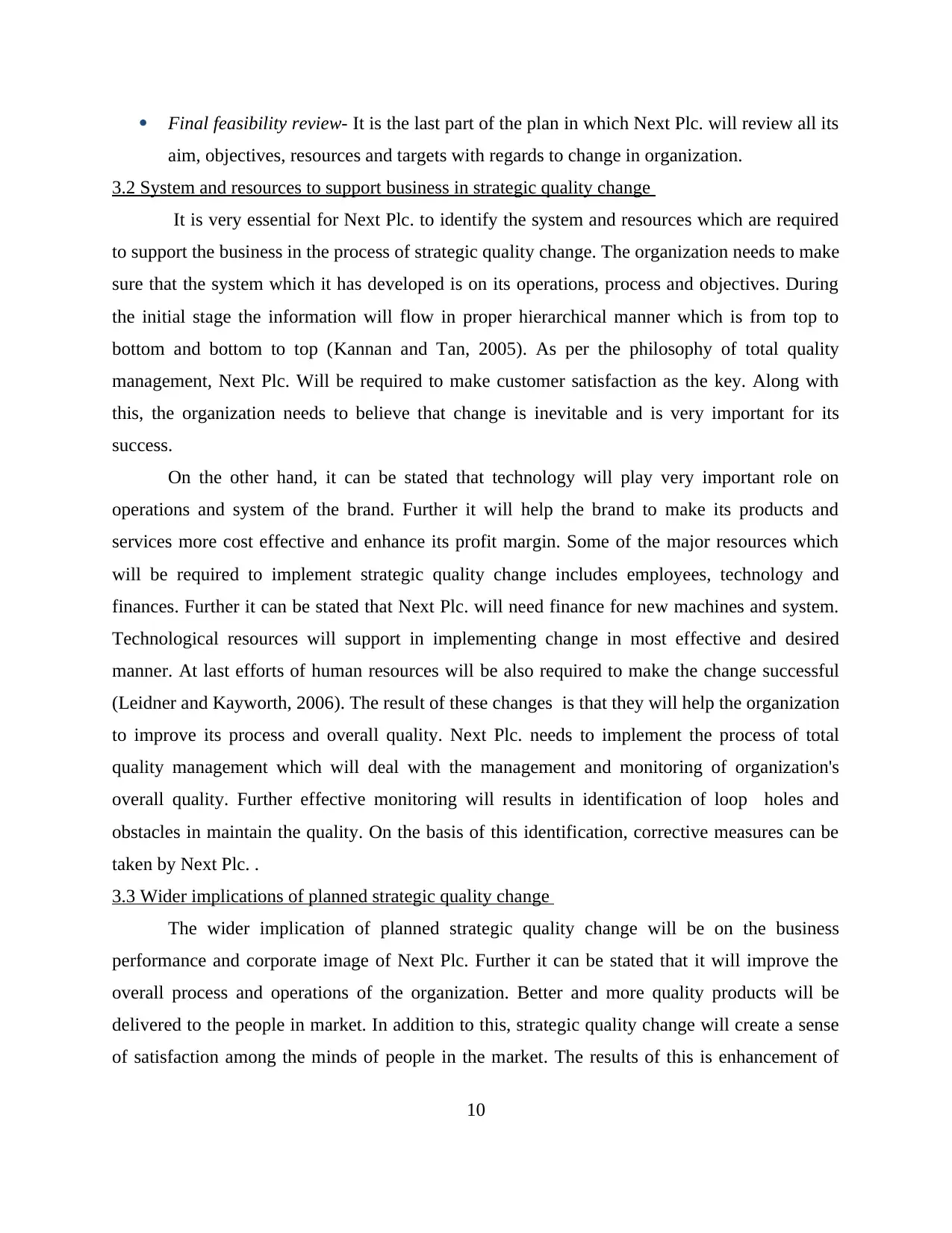
Final feasibility review- It is the last part of the plan in which Next Plc. will review all its
aim, objectives, resources and targets with regards to change in organization.
3.2 System and resources to support business in strategic quality change
It is very essential for Next Plc. to identify the system and resources which are required
to support the business in the process of strategic quality change. The organization needs to make
sure that the system which it has developed is on its operations, process and objectives. During
the initial stage the information will flow in proper hierarchical manner which is from top to
bottom and bottom to top (Kannan and Tan, 2005). As per the philosophy of total quality
management, Next Plc. Will be required to make customer satisfaction as the key. Along with
this, the organization needs to believe that change is inevitable and is very important for its
success.
On the other hand, it can be stated that technology will play very important role on
operations and system of the brand. Further it will help the brand to make its products and
services more cost effective and enhance its profit margin. Some of the major resources which
will be required to implement strategic quality change includes employees, technology and
finances. Further it can be stated that Next Plc. will need finance for new machines and system.
Technological resources will support in implementing change in most effective and desired
manner. At last efforts of human resources will be also required to make the change successful
(Leidner and Kayworth, 2006). The result of these changes is that they will help the organization
to improve its process and overall quality. Next Plc. needs to implement the process of total
quality management which will deal with the management and monitoring of organization's
overall quality. Further effective monitoring will results in identification of loop holes and
obstacles in maintain the quality. On the basis of this identification, corrective measures can be
taken by Next Plc. .
3.3 Wider implications of planned strategic quality change
The wider implication of planned strategic quality change will be on the business
performance and corporate image of Next Plc. Further it can be stated that it will improve the
overall process and operations of the organization. Better and more quality products will be
delivered to the people in market. In addition to this, strategic quality change will create a sense
of satisfaction among the minds of people in the market. The results of this is enhancement of
10
aim, objectives, resources and targets with regards to change in organization.
3.2 System and resources to support business in strategic quality change
It is very essential for Next Plc. to identify the system and resources which are required
to support the business in the process of strategic quality change. The organization needs to make
sure that the system which it has developed is on its operations, process and objectives. During
the initial stage the information will flow in proper hierarchical manner which is from top to
bottom and bottom to top (Kannan and Tan, 2005). As per the philosophy of total quality
management, Next Plc. Will be required to make customer satisfaction as the key. Along with
this, the organization needs to believe that change is inevitable and is very important for its
success.
On the other hand, it can be stated that technology will play very important role on
operations and system of the brand. Further it will help the brand to make its products and
services more cost effective and enhance its profit margin. Some of the major resources which
will be required to implement strategic quality change includes employees, technology and
finances. Further it can be stated that Next Plc. will need finance for new machines and system.
Technological resources will support in implementing change in most effective and desired
manner. At last efforts of human resources will be also required to make the change successful
(Leidner and Kayworth, 2006). The result of these changes is that they will help the organization
to improve its process and overall quality. Next Plc. needs to implement the process of total
quality management which will deal with the management and monitoring of organization's
overall quality. Further effective monitoring will results in identification of loop holes and
obstacles in maintain the quality. On the basis of this identification, corrective measures can be
taken by Next Plc. .
3.3 Wider implications of planned strategic quality change
The wider implication of planned strategic quality change will be on the business
performance and corporate image of Next Plc. Further it can be stated that it will improve the
overall process and operations of the organization. Better and more quality products will be
delivered to the people in market. In addition to this, strategic quality change will create a sense
of satisfaction among the minds of people in the market. The results of this is enhancement of
10
Paraphrase This Document
Need a fresh take? Get an instant paraphrase of this document with our AI Paraphraser
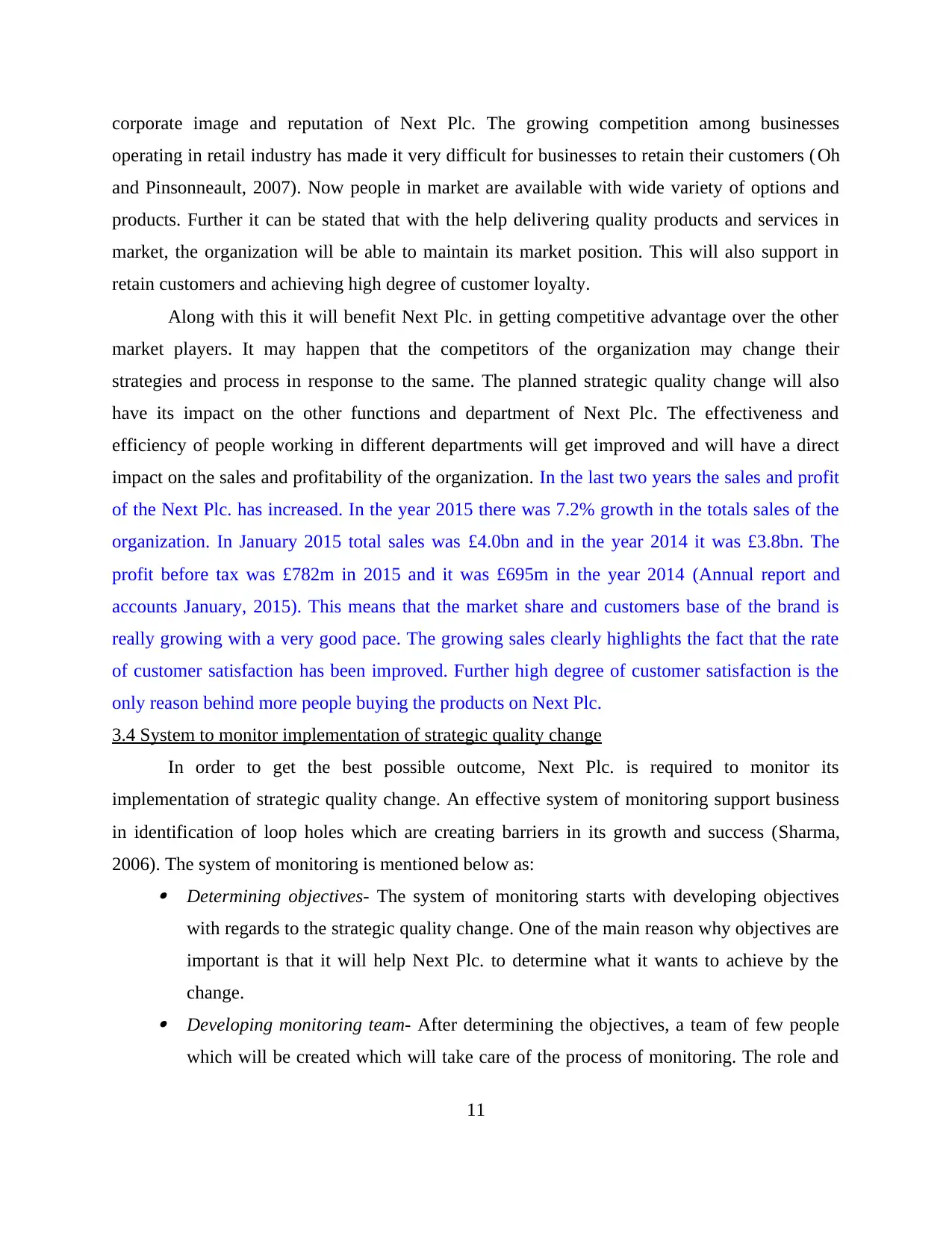
corporate image and reputation of Next Plc. The growing competition among businesses
operating in retail industry has made it very difficult for businesses to retain their customers (Oh
and Pinsonneault, 2007). Now people in market are available with wide variety of options and
products. Further it can be stated that with the help delivering quality products and services in
market, the organization will be able to maintain its market position. This will also support in
retain customers and achieving high degree of customer loyalty.
Along with this it will benefit Next Plc. in getting competitive advantage over the other
market players. It may happen that the competitors of the organization may change their
strategies and process in response to the same. The planned strategic quality change will also
have its impact on the other functions and department of Next Plc. The effectiveness and
efficiency of people working in different departments will get improved and will have a direct
impact on the sales and profitability of the organization. In the last two years the sales and profit
of the Next Plc. has increased. In the year 2015 there was 7.2% growth in the totals sales of the
organization. In January 2015 total sales was £4.0bn and in the year 2014 it was £3.8bn. The
profit before tax was £782m in 2015 and it was £695m in the year 2014 (Annual report and
accounts January, 2015). This means that the market share and customers base of the brand is
really growing with a very good pace. The growing sales clearly highlights the fact that the rate
of customer satisfaction has been improved. Further high degree of customer satisfaction is the
only reason behind more people buying the products on Next Plc.
3.4 System to monitor implementation of strategic quality change
In order to get the best possible outcome, Next Plc. is required to monitor its
implementation of strategic quality change. An effective system of monitoring support business
in identification of loop holes which are creating barriers in its growth and success (Sharma,
2006). The system of monitoring is mentioned below as:
Determining objectives- The system of monitoring starts with developing objectives
with regards to the strategic quality change. One of the main reason why objectives are
important is that it will help Next Plc. to determine what it wants to achieve by the
change.
Developing monitoring team- After determining the objectives, a team of few people
which will be created which will take care of the process of monitoring. The role and
11
operating in retail industry has made it very difficult for businesses to retain their customers (Oh
and Pinsonneault, 2007). Now people in market are available with wide variety of options and
products. Further it can be stated that with the help delivering quality products and services in
market, the organization will be able to maintain its market position. This will also support in
retain customers and achieving high degree of customer loyalty.
Along with this it will benefit Next Plc. in getting competitive advantage over the other
market players. It may happen that the competitors of the organization may change their
strategies and process in response to the same. The planned strategic quality change will also
have its impact on the other functions and department of Next Plc. The effectiveness and
efficiency of people working in different departments will get improved and will have a direct
impact on the sales and profitability of the organization. In the last two years the sales and profit
of the Next Plc. has increased. In the year 2015 there was 7.2% growth in the totals sales of the
organization. In January 2015 total sales was £4.0bn and in the year 2014 it was £3.8bn. The
profit before tax was £782m in 2015 and it was £695m in the year 2014 (Annual report and
accounts January, 2015). This means that the market share and customers base of the brand is
really growing with a very good pace. The growing sales clearly highlights the fact that the rate
of customer satisfaction has been improved. Further high degree of customer satisfaction is the
only reason behind more people buying the products on Next Plc.
3.4 System to monitor implementation of strategic quality change
In order to get the best possible outcome, Next Plc. is required to monitor its
implementation of strategic quality change. An effective system of monitoring support business
in identification of loop holes which are creating barriers in its growth and success (Sharma,
2006). The system of monitoring is mentioned below as:
Determining objectives- The system of monitoring starts with developing objectives
with regards to the strategic quality change. One of the main reason why objectives are
important is that it will help Next Plc. to determine what it wants to achieve by the
change.
Developing monitoring team- After determining the objectives, a team of few people
which will be created which will take care of the process of monitoring. The role and
11

duty of this team will be to assess operations and activities of the organization. Further
they will be also responsible for ensure that the change process is delivering best
possible outcome.
Comparison of actual performance with desired one- The system of monitoring will
also consist of stage in which comparison of actual performance and desired will be
done. In case if there is a gap between the two then, the monitoring team will be
required to take corrective measures.
Taking measures- It is the last part of an effective monitoring system in which the
monitoring team will take measures and corrective actions to eliminate the loop holes
which are acting as a barriers in achievement of desired results.
The organization will be required to adopted for a proper quality manual which help in
maintaining quality of the products. The manual will consist of three main elements which are
ISO 9001 quality standards, quality department and policy. The policy will be communicated to
all the workers and Next will make sure that all workers strictly follow the same. Monitoring of
all process and operations will be carried out by quality department.
The quality manual for Next Plc is mentioned below as:
Quality policy- The policy of Next Plc. Aims at meeting and exceeding expectations of
all its customers by providing high quality of products its customers. In addition to this
the policy also aims developing mutual and profitable relationship with its consumers. It
also includes the fact that the organization is required to achieve its commitment towards
quality, schedule and cost (Yang, 2008). Development of creativity and competency level
of staff is also a very important part of Next Plc. quality policy.
Quality objectives- One of the main objective of the organization is to provide best
quality of products to all its customers. Another objective is to seek and implement ways
through which quality can be improved. Its objective is to implement such kind of
management system that can cope up with international standards related to good
practises.
Regulatory requirements- This includes quality assurance, quality control and meeting
the standards developed in ISO 9001. In all stages such as development, production etc.
Next Plc. Is required to take care of quality of products.
12
they will be also responsible for ensure that the change process is delivering best
possible outcome.
Comparison of actual performance with desired one- The system of monitoring will
also consist of stage in which comparison of actual performance and desired will be
done. In case if there is a gap between the two then, the monitoring team will be
required to take corrective measures.
Taking measures- It is the last part of an effective monitoring system in which the
monitoring team will take measures and corrective actions to eliminate the loop holes
which are acting as a barriers in achievement of desired results.
The organization will be required to adopted for a proper quality manual which help in
maintaining quality of the products. The manual will consist of three main elements which are
ISO 9001 quality standards, quality department and policy. The policy will be communicated to
all the workers and Next will make sure that all workers strictly follow the same. Monitoring of
all process and operations will be carried out by quality department.
The quality manual for Next Plc is mentioned below as:
Quality policy- The policy of Next Plc. Aims at meeting and exceeding expectations of
all its customers by providing high quality of products its customers. In addition to this
the policy also aims developing mutual and profitable relationship with its consumers. It
also includes the fact that the organization is required to achieve its commitment towards
quality, schedule and cost (Yang, 2008). Development of creativity and competency level
of staff is also a very important part of Next Plc. quality policy.
Quality objectives- One of the main objective of the organization is to provide best
quality of products to all its customers. Another objective is to seek and implement ways
through which quality can be improved. Its objective is to implement such kind of
management system that can cope up with international standards related to good
practises.
Regulatory requirements- This includes quality assurance, quality control and meeting
the standards developed in ISO 9001. In all stages such as development, production etc.
Next Plc. Is required to take care of quality of products.
12
⊘ This is a preview!⊘
Do you want full access?
Subscribe today to unlock all pages.

Trusted by 1+ million students worldwide
1 out of 18
Related Documents
Your All-in-One AI-Powered Toolkit for Academic Success.
+13062052269
info@desklib.com
Available 24*7 on WhatsApp / Email
![[object Object]](/_next/static/media/star-bottom.7253800d.svg)
Unlock your academic potential
Copyright © 2020–2025 A2Z Services. All Rights Reserved. Developed and managed by ZUCOL.





